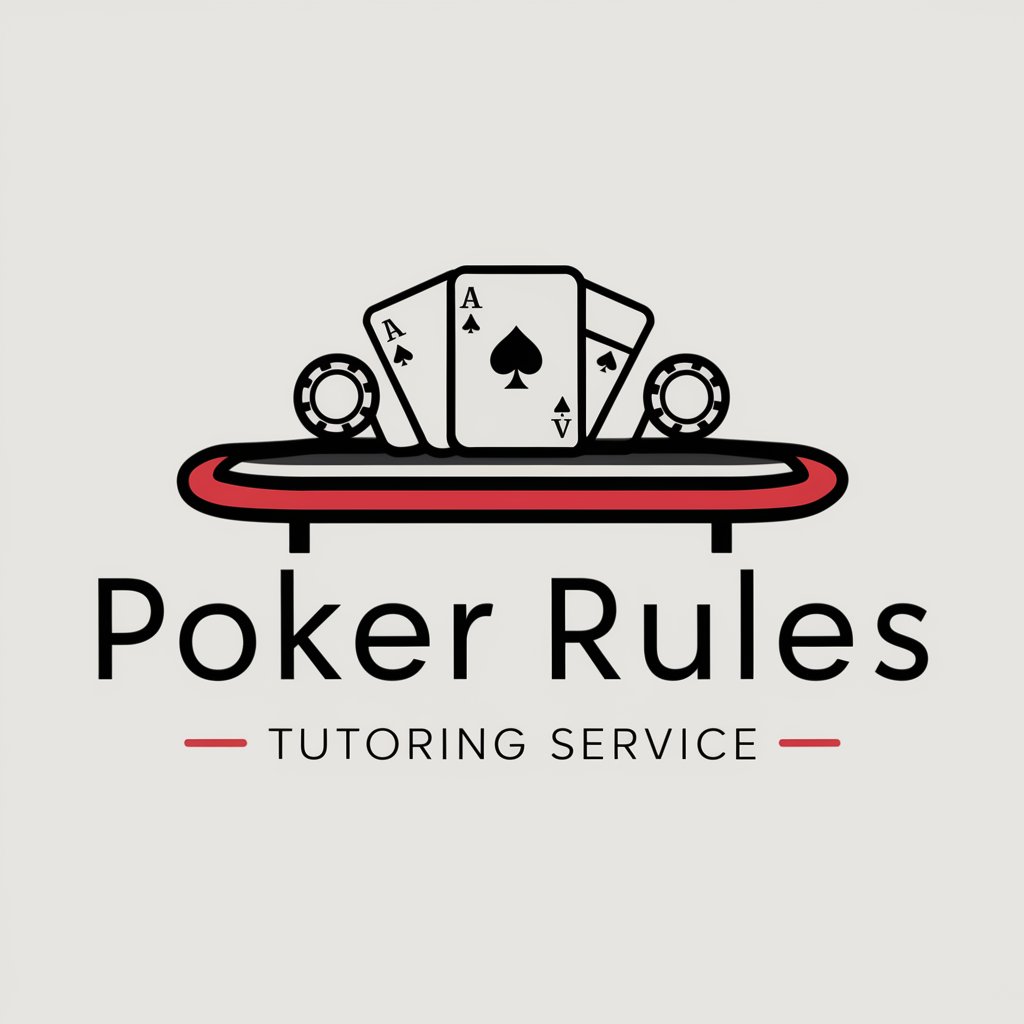
Poker Rules - Poker Rule Guide

Welcome! Ready to master the rules of poker?
Master poker with AI-powered guidance
Explain the basic rules of Texas Hold'em poker.
What are the hand rankings in poker?
Can you provide some beginner strategies for poker?
How does the betting structure work in Omaha poker?
Get Embed Code
Overview of Poker Rules
Poker Rules is designed as an educational tool focused on the comprehensive teaching and understanding of poker games, including their rules, strategies, terminology, and the nuances that come with different variants. The purpose is to demystify poker for beginners while providing depth for more experienced players. Through detailed explanations, examples, and scenarios, Poker Rules aims to make learning poker accessible and engaging. For instance, it can take a user through the step-by-step process of playing Texas Hold'em, from the initial blinds to the showdown, illustrating the strategic considerations at each stage, such as when to fold, call, or raise based on the strength of one's hand and the community cards. Powered by ChatGPT-4o。

Key Functions of Poker Rules
Rule Explanation
Example
Explains the basic and complex rules of various poker games, including Texas Hold'em, Omaha, and Seven-Card Stud.
Scenario
A beginner wants to learn the differences between Texas Hold'em and Omaha. Poker Rules provides a side-by-side comparison of the rules, such as the number of hole cards received and how a winning hand can be formed.
Strategy Guidance
Example
Offers insights into poker strategies, ranging from basic to advanced levels.
Scenario
An intermediate player is struggling with betting strategies in no-limit Texas Hold'em. Poker Rules offers guidance on pot odds, reading opponents, and managing the bankroll to improve their game.
Terminology Clarification
Example
Defines and clarifies poker terminology and slang, making the language of poker more accessible.
Scenario
A user comes across terms like 'flop,' 'turn,' 'river,' and 'nuts' while playing online. Poker Rules provides clear definitions and uses these terms in sentences to demonstrate their meanings in context.
Scenario Simulation
Example
Presents hypothetical poker scenarios to explain how to navigate specific situations.
Scenario
A player is unsure how to act after being dealt a pocket pair of aces in early position. Poker Rules walks through the scenario, discussing pre-flop strategy, the importance of position, and how to maximize potential winnings while minimizing risks.
Target User Groups for Poker Rules
Beginners
Individuals new to poker who require a foundational understanding of the game's rules, strategies, and language. They benefit from Poker Rules by getting a structured, easy-to-follow introduction to various poker games.
Intermediate Players
Players with some experience who seek to deepen their knowledge, refine their strategies, and learn more about the intricacies of different poker variants. They find value in the strategic insights and scenario-based learning that Poker Rules offers.
Poker Enthusiasts
Those who have a passion for the game and are always looking to learn more, regardless of their skill level. They enjoy the comprehensive nature of the information, from terminology to advanced strategy discussions.

How to Use Poker Rules
Start Free Trial
Visit yeschat.ai to access a free trial of Poker Rules without needing to log in or subscribe to ChatGPT Plus.
Explore Features
Familiarize yourself with the interface and explore various features such as rule explanations, game strategies, and terminology guides.
Ask Questions
Utilize the query box to ask specific questions about poker rules, strategies, game types, or terminology.
Apply Knowledge
Apply the insights and knowledge gained to improve your understanding and gameplay in real poker scenarios.
Regular Updates
Check back regularly for updates and new content to stay informed about the latest poker rules and strategies.
Try other advanced and practical GPTs
テストデータ検証001
Enhance Data Integrity with AI

Carpenter
Crafting Mastery with AI-Powered Carpentry Insight

Black
Dive Deep into the Essence of Black

E-Commerce Mentor
AI-powered e-commerce and dropshipping mentor

Database Management
Empowering data management with AI

Astro Helper
Unlock your cosmic potential with AI.

Exotic Plants
Cultivate the extraordinary with AI

Anxiety Buster
Empowering You to Overcome Anxiety with AI

Weddings
AI-powered Wedding Planning Simplified

Drink
Sip the Science of Beverages

Mountain
Exploring Mountains with AI

Jackie's Fashionista
Innovating Fashion with AI

Poker Rules Q&A
What are the basic rules of Texas Hold'em?
In Texas Hold'em, each player is dealt two private cards (hole cards), and five community cards are dealt face-up on the 'board.' Players seek to make the best five-card poker hand using any combination of the seven cards available to them. Betting occurs in four rounds: after the hole cards are dealt, after the flop (first three community cards), after the turn (fourth community card), and after the river (fifth community card).
How do blinds work in poker?
Blinds are mandatory bets placed by the two players to the left of the dealer button in games like Texas Hold'em and Omaha. The player directly to the dealer's left posts the small blind, while the next player posts the big blind. Blinds ensure there's always money in the pot and contribute to the game's dynamics by encouraging players to engage in the hand.
Can you explain what a 'poker face' is?
A 'poker face' is an expressionless face that reveals no insight into the individual's current hand or intentions. Players use a poker face to prevent opponents from gauging their hand strength based on their facial expressions or reactions, thereby gaining a strategic advantage.
What does 'all-in' mean in poker?
Going 'all-in' means betting all of one's chips on the current hand. It's a high-stakes move used when a player believes they have a winning hand or wants to bluff their opponents into folding. If another player calls and wins, the all-in player may be eliminated from the game if they cannot cover the bet.
What are the different types of poker games?
Poker includes several variations, each with its own rules and strategies. Popular types include Texas Hold'em, Omaha, Seven-Card Stud, Razz, and Five-Card Draw. Each variant has unique betting structures (like no-limit, pot-limit, and fixed-limit) and different methods for creating a winning hand.